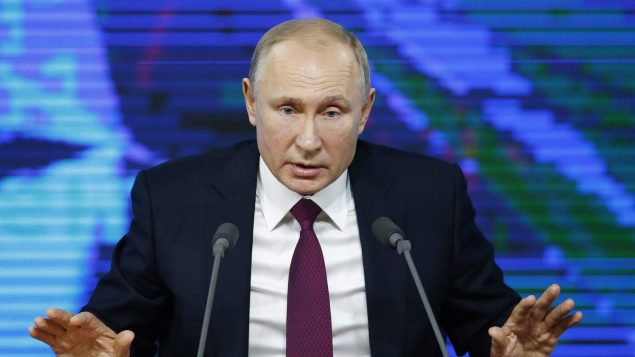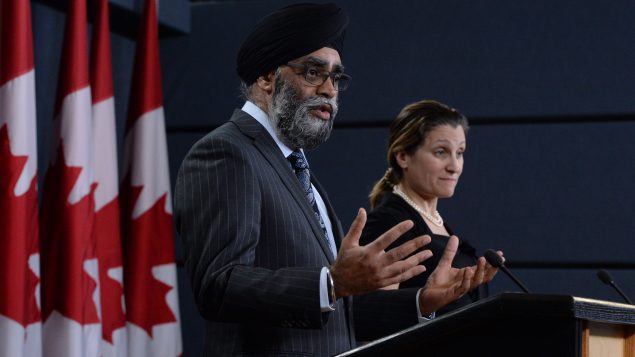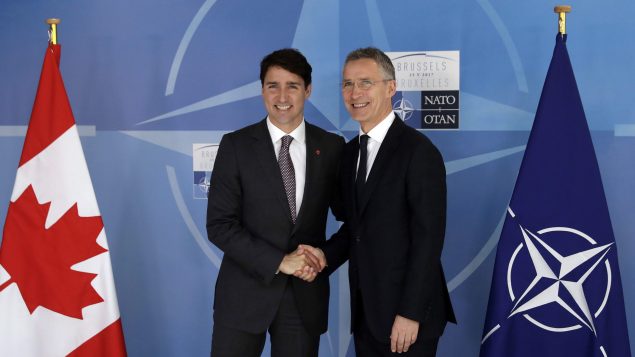NATO Secretary General Jens Stoltenberg will visit Canada next week for talks with Prime Minister Justin Trudeau amid continuing tensions with Russia over Ukraine and Russian compliance with the Intermediate-Range Nuclear Forces Treaty.
The two leaders will meet at the Canadian Forces Base in Petawawa, Ontario, on July 15 and will have lunch with Canadian service members, officials at the Prime Minister’s Office announced Wednesday. Stoltenberg will also travel to Toronto later that day, to deliver a keynote address at Massey College.
“I look forward to meeting with Secretary General Stoltenberg to discuss pressing issues facing the Alliance and its partners, and to highlight Canada’s leadership on security challenges around the world,” Trudeau said in a statement.
“This year marks NATO’s 70th anniversary. Now more than ever, it’s vital that NATO Allies work together to defend the rules-based international order, and build a more peaceful, prosperous future for people around the world.”
Tensions over arms control treaty

Russian President Vladimir speaks during his annual news conference in Moscow, Russia, Thursday, Dec. 20, 2018. Speaking at news conference Thursday, Putin pointed at the U.S. intention to withdraw from the 1987 Intermediate-Range Nuclear Forces (INF) Treaty, saying that if the U.S. puts intermediate-range missiles in Europe, Russia will be forced to take countermeasures. (Alexander Zemlianichenko/AP Photo)
Earlier this month Russian President Vladimir Putin formally suspended Russia’s participation in the Intermediate-Range Nuclear Forces (INF) Treaty, months after the Trump administration pulled the U.S. out of the key arms control treaty, accusing Moscow of violating it.
Signed in 1987, the INF Treaty banned an entire class of nuclear weapons. It required the U.S. and the former Soviet Union to destroy their nuclear ground-launched ballistic and cruise missiles with “intermediate” range capabilities between 500 and 5,500 kilometres. Production, testing and deployment of the weapons were also banned.
However, Washington has accused Russia of developing and deploying the SSC-8/ 9M729 missile system.
- NATO wants to keep the Arctic an area of low tensions, Stoltenberg
- NATO could invoke collective defence if attacked in cyberspace, Stoltenberg warns
According to NATO, the 9M729 is mobile and easy to hide. It is capable of carrying nuclear warheads. It reduces warning times to minutes, lowering the threshold for nuclear conflict. And it can reach European capitals from its launch points in European Russia.
Moscow denies that the missile system exceeds the 500 kilometre range limit. It argues that Washington’s decision to withdraw from the INF had nothing to do with Russia and everything to do with China.
Beijing is not party to the treaty and has rapidly expanded its missile arsenal as part of a military strategy designed to counter U.S. and allied military power in Asia, according to a research paper by the U.S.-China Economic and Security Review Commission.
The paper argues China has over a 1,000 missiles in its arsenal that would be banned if Beijing were subject to the provisions of the INF Treaty.
Talks between Russia and NATO on saving the treaty last week did not produce any significant results.
Showcasing Canada’s ‘leadership’ in NATO

Defence Minister Harjit Sajjan and Foreign Affairs Minister Chrystia Freeland make an announcement in Ottawa, Monday, March 18, 2019 about Canada extending its military missions in Ukraine and Iraq, both of which were due to expire at the end of the month. (Sean Kilpatrick/THE CANADIAN PRESS)
Stoltenberg’s visit, his third trip to Canada since becoming the secretary general of the North Atlantic Treaty Organization, will also be an opportunity for the Liberal government to “highlight Canada’s steadfast commitment to the Alliance,” officials said.
Canada and several other NATO nations are facing pressure from the Trump administration to increase defence spending to reach the goal of 2 per cent of defence expenditures as share of the GDP.
Despite increases in defence spending by the Liberal government, Canada’s 2019 defence expenditures were projected to be about 1.27 per cent of its GDP, according to the latest statistics compiled by NATO.
Canada also falls significantly short of another key NATO yardstick when it comes to how much money from its defence budget goes to acquiring new equipment. In 2019, Canada was projected to spend 11.2 per cent of its defence budget on new equipment compared to the NATO goal of 20 per cent.
Instead, Trudeau will underscore Canada’s leadership within NATO, including at the head of the enhanced Forward Presence Battlegroup in Latvia and the NATO training and capacity building mission in Iraq, of the NATO Standing Maritime Group 2, and it’s training mission in Ukraine, officials said.
Canada became a founding member of NATO in 1949. Membership in NATO and the U.S.-Canadian bi-national North American Aerospace Defence (NORAD) Command are considered the two cornerstones of Ottawa’s defence and security policy.
With files from The Associated Press and Reuters







For reasons beyond our control, and for an undetermined period of time, our comment section is now closed. However, our social networks remain open to your contributions.